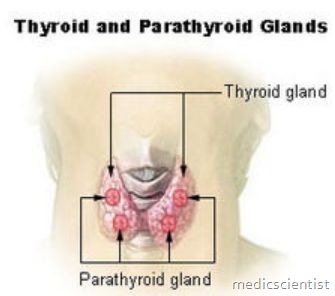Article Contents ::
Thyroid Disorders
Thyroid gland produces 2 hormones –
- Thyroxine or T4 and
- Triiodothyronine or T3.
Functions of the thyroid hormones are:
- · They help in cell differentiation
- · Maintain temperature and metabolism.
Disorders of Thyroid are due to
- 1. Overproduction ofthyroid hormone – Thyrotoxicosis
- 2. Decreased production of thyroid hormone – Hypothyroidism
- 3. Thyroid -nodules
- 4. Thyroid cancers.
- The thyroid glant has two lobes connected by an isthmus.
- Weight is 12-20 gms.
- It is highly vascular and soft.
- 4 parathyroid glands are situated behind the thyroid glands.
- Thyroid medullary C cells produce calcitonin hormone which has the effect of lowering the calcium levels.
Abnormalities associated with development of thyroid gland may be –
- · Ectopic thyroid
- · Lingual thyroid
- · Thyroglossal duct cysts
- · Thyroid agenesis
- · Congenital hypothyroidism (1 in 4000 new-borns).
- Thyrotoxicosis factitia is due to self administration of thyroid hormones and not a true thyroid disease.
- TSH or thyroid stimulating hormone is secreted by anterior pituitary under the influence of TRH or thyrotropin releasing hormone.
Biofeedback :
- Thyroid hormones have a negative feedback on the release of TSH and TRH i.e.
- when the level of thyroid hormones in the blood is high, TSH release is decreased.
Examination of the Thyroid
- The skin is typically warm and moist, and the hair may be thin and fine.
- The patient is examined from the front and side for· any masses, prominent veins or scar.
- The thyroid is palpated from behind the patient with both hands. The patient is asked to swallow and the thyroid is palpated for size, consistency, nodules and tenderness.
- The physical examination may be notable for hyperactivity and rapid speech.
- Many patients have stare (lid retraction) and lid lag, representing sympathetic hyperactivity
- In increased vasculatiry of the gland, a bruit is found over the gland.
- In retrosternal goiters, venous distention is seen over the neck, with difficulty in breathing especially when the arms are raised above the head (Pemberton’s sign).
- Tachycardia is common, the pulse is irregularly irregular in patients with atrial fibrillation, systolic hypertension may be present,
- Lymphadenopathy of supraclavicular and cervical lymph nodes is examined.
- Tremor, proximal muscle weakness, and hyperreflexia are other frequent findings.
- Exophthalmos, periorbital and conjunctival edema, limitation of eye movement, and infiltrative dermopathy (pretibial myxedema) occur only in patients with Graves’ disease.
Thyroid Disorders Laboratory tests
- TSH is assayed to see if level is suppressed, normal or elevated.
- In primary abnormality of thyroid function, TSH level may be suppressed or elevated, but never normal.
- In thyrotoxicosis, TSH is suppressed.
- In hypothyroidism, TSH levels are elevated.
- Always free T3 and T4 are estimated as the total T3 and T4 are highly protein-bound and are affected by illness or medications.
- To confirm thyrotoxicosis, free T4 level elevation is sufficient.
- Elevated TSH level is not enough to confirm hypothyroidism, therefore TSH and free T4 should both be done.
- Autoimmune thyroid disease is detected by measuring antibody against thyroid peroxidase and thyroglobulin.
- Radio-iodine uptake and thyroid scanning helps to determine thyroid function and localize nodules and cancers.
- Fine-needle aspiration biopsy of thyroid is used to evaluate thyroid nodules.
- Thyroid ultrasound is used to detect nodule and cysts more than 3 mm.


